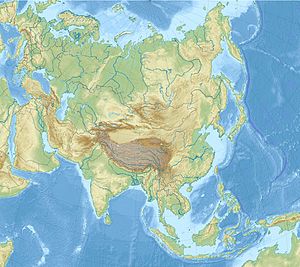
Back Tapiz de Sampul Spanish Dewangga Sampul ID Arazzo di Sampul Italian Sampul gobleni Turkish 山普拉掛毯 Chinese
| Sampul tapestry | |
|---|---|
Full length Detail Probable Yuezhi soldier in red jacket and trousers, in the Sampul tapestry. Embroidered in Hellenistic style, with motif of a centaur, 1st century AD, Sampul, Ürümqi Xinjiang Region Museum.[1] | |
| Material | Embroided tapestry |
| Created | 1st century AD |
| Discovered | Sampul, 37°01′13″N 80°06′47″E / 37.020199°N 80.113078°E |
Sampul tapestry is an ancient woolen wall-hanging found at the Tarim Basin settlement of Sampul in Lop County, Hotan Prefecture, Xinjiang, China,[2] close to the ancient city of Khotan.[3] The object has many Hellenistic period features, including a Greek centaur and diadem, linking it to the Greco-Bactrian Kingdom (formed after the conquest of the Achaemenid Empire by Alexander the Great of Macedon and establishment of the Seleucid Empire). It may represent a Yuezhi soldier, in red jacket and trousers, from the 1st century CE.[4][5] Alternatively, the soldier (king) is possibly a Greco-Bactrian,[6] an Hellenized Saka or a Greco-Saka military aristocrat.[7] The man's head features (cheek, mouth, blue eyes,[8] nose, hairband) and the spear representation are modeled similarly with the depiction of Alexander the Great on a medallion found from Roman Egypt (215-243 AD)[9] and could represent the king.[10] Overall, the Sampul tapestry belongs to the Greco-Bactrian culture.
- ^ Yatsenko, Sergey A. (2012). "Yuezhi on Bactrian Embroidery from Textiles Found at Noyon uul, Mongolia" (PDF). The Silk Road. 10: 45–46.
- ^ Wood 2002, p. 37, p. 255
- ^ Christopoulos, Lucas (August 2012), "Hellenes and Romans in Ancient China (240 BC – 1398 AD)," in Victor H. Mair (ed), Sino-Platonic Papers, No. 230, Chinese Academy of Social Sciences, University of Pennsylvania Department of East Asian Languages and Civilizations, p. 15, ISSN 2157-9687.
- ^ Yatsenko, Sergey A. (2012). "Yuezhi on Bactrian Embroidery from Textiles Found at Noyon uul, Mongolia" (PDF). The Silk Road. 10: 45–46.
- ^ Betts, Alison; Vicziany, Marika; Jia, Peter Weiming; Castro, Angelo Andrea Di (19 December 2019). The Cultures of Ancient Xinjiang, Western China: Crossroads of the Silk Roads. Archaeopress Publishing Ltd. p. 104. ISBN 978-1-78969-407-9.
- ^ The ornamental trousers from Sampula (Xinjiang, China): their origins and Biography. Antiquity 83 (2009): 1065-1075. p.6
- ^ Lucas, Christopoulos; Dionysian rituals and the Golden Zeus of China pp.63-118
- ^ According to Pseudo-Callisthenes, Alexander right eye was heavily-lidded and black/dark blue (kuanoblefaron) and the left one was blue (glaukos). Ps.-Callisthenes, Bios Alexandrou 1.13.3 (ca AD 300); Brown 19 49; Stewart 1993, 346, T 18.
- ^ "Medallion with Alexander the Great | the Walters Art Museum".
- ^ Christopoulos, Lucas (August 2021). "Hellenes and Romans in Ancient China" Sino-Platonic Papers. 230. p.15
© MMXXIII Rich X Search. We shall prevail. All rights reserved. Rich X Search




